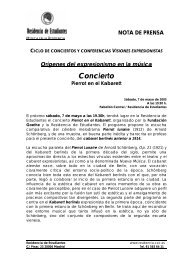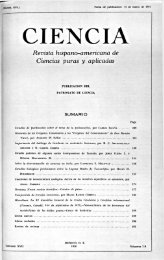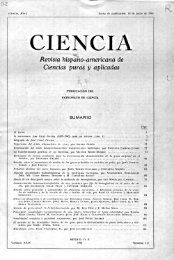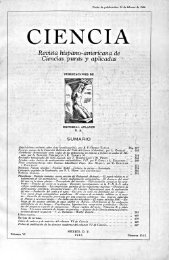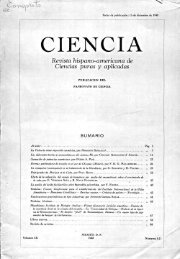C I E N C I A - Consejo Superior de Investigaciones Científicas
C I E N C I A - Consejo Superior de Investigaciones Científicas
C I E N C I A - Consejo Superior de Investigaciones Científicas
Create successful ePaper yourself
Turn your PDF publications into a flip-book with our unique Google optimized e-Paper software.
CIENCIA<br />
menor presión. Segundo.—Se emplea sólo una<br />
fracción <strong>de</strong> la «anudad <strong>de</strong>l disolvente, (pie por<br />
eso se liltra y <strong>de</strong>stila en menos tiempo. Terce<br />
ro.—Se emplea una cantidad muy |iet|ticña <strong>de</strong><br />
catalizador, que causa menos dificulta<strong>de</strong>s para<br />
su ici upi i n y su utilización <strong>de</strong> nuevo. Cuar<br />
to.—En comparación con la reacción <strong>de</strong> Can-<br />
niz/aro no se necesitan reactivos y elaboraciones<br />
costosas como extraer el benceno, lavar y puri<br />
ficar el producto final. El ahorro se expresa<br />
a<strong>de</strong>más en ganancia <strong>de</strong> tiempo.<br />
K Piperonal I Catal. Pd. en<br />
carbón al 5%<br />
2) Hitlrogenación a presión elevada (alre<strong>de</strong>dor<br />
tle 10 at) y temperatura elevada.<br />
3) Por, reacción <strong>de</strong> Cannizaro cruzada.<br />
Los tres caminos se han elaborado en escala<br />
técnita y se han consi<strong>de</strong>rado las posibilida<strong>de</strong>s<br />
técnicas y económicas.<br />
El mejor camino es la hitlrogenación a pre<br />
sión alre<strong>de</strong>dor <strong>de</strong> 40 at y temperaturas entre<br />
70 y 90°, si se dispone <strong>de</strong> una autoclave a<strong>de</strong><br />
cuada.<br />
2. HidroRenac ones a alia presión.<br />
em 1<br />
<strong>de</strong> disolvente Temperatura Tiempo Consumo<br />
<strong>de</strong> hidróceno Consumo<br />
teórico<br />
Consumo rn<br />
* <strong>de</strong>l teórico<br />
750 g 10 K Inopropanol 1 500 em' 70» lh 35min 1801 1121 160%<br />
lOOOg 8« iHopropanol '¿ IKK) em' 95° lh 2051 1491 138%<br />
1 250 K 7g laopropanol 2 000 em* »5° 2h 50min 3521 1861 189%<br />
1250K 7K laopropanol 2 000 em' 95* ¿h 40min 3451 1SÜ 1 182,5%<br />
1 000 K •>g 2 000 em' éter iaopropílico 80* lh 1 Omití 1931 1491 130%<br />
• La cantidad <strong>de</strong> catalizador pue<strong>de</strong> regular la velocidad <strong>de</strong> la hidrogenación, igualmente «e ve la influencia<br />
<strong>de</strong> la temperatura.<br />
3. La reacción cruzada <strong>de</strong> Cannizzaro.<br />
En un frasco Pyrcx <strong>de</strong> 19 1 ron agitador, refrigerante<br />
<strong>de</strong> reflujo, embudo para gotear y termómetro interno<br />
se disuelven 5 Kg <strong>de</strong> potasa en 7,5 1 <strong>de</strong> metanol<br />
absoluto. Cuando la temperatura interior es <strong>de</strong> 60° se<br />
agrega una mezcla, <strong>de</strong> 4,5 Kg <strong>de</strong> piperonal, 3 I formol<br />
y 3 1 metanol. Se mantiene la temperatura interior a<br />
60-70° durante la adición <strong>de</strong> la mezcla y 3 h más a esta<br />
temperatura <strong>de</strong>spués <strong>de</strong> haber introducido todo, se <strong>de</strong>stila<br />
el metanol al día siguiente y se agota el último resto<br />
con ayuda <strong>de</strong>l vacío. Ahora se agregan 9 1 <strong>de</strong> agua fría<br />
al residuo <strong>de</strong> la <strong>de</strong>stilación y se enfría.<br />
Se forman dos capas, se separa la superior y la inferior<br />
se extrae varias veces con benceno. La solución<br />
bencéníca se lava con agua y se seca con sulfato <strong>de</strong> sodio.<br />
Después <strong>de</strong> filtrar se <strong>de</strong>stila el benceno y el residuo<br />
se reúne con la capa superior antes mencionada.<br />
Para purificar este alcohol crudo se agita con agua caliente<br />
y se enfría para <strong>de</strong>jar cristalizar el alcohol. Esa<br />
operación se repite hasta que el agua muestra una reacción<br />
casi neutra.<br />
Las aguas se extraen con benceno, que se reintegra<br />
al proceso para el próximo lote.<br />
Lo» rendimientos oscilaron entre 65 y 689f.<br />
RESUMEN<br />
El alcohol piperonílico se ha preparado por<br />
tres caminos:<br />
1) Hidrogenación a presión <strong>de</strong> 1-3 at. y temperatura<br />
ambiente.<br />
16«<br />
ZUSAMMENFASSUNG<br />
Es wur<strong>de</strong> I'i|>eronylalkohol au! drei verschie<strong>de</strong>ne<br />
Weisen hergestellt:<br />
1) Durch Hydrierung mit Drucken von I<br />
bis 3 Atmosphären unb bei Zimmertemperatur.<br />
2) Durch Hydrierung bei erhöhtem Druck<br />
(um 10 at) und bei erhöhter Temperatur.<br />
3) Mit Hilfe einer gemischten Cannizaro-<br />
Reaktion.<br />
Alle drei Wege wur<strong>de</strong>n im Technikums<br />
masstab ausgearbeitet und ihere technischen<br />
und wirtschaftlichen Möglichkeiten einer ein<br />
gehen<strong>de</strong>n Betrachtung unterzogen.<br />
Als beste Herstellungsart wurtle die Hydrie<br />
rung bei Drucken um 40 Atmosphären und Tem<br />
peraturen zwischen 70° und 90 gefun<strong>de</strong>n, falls<br />
ein entsprechen<strong>de</strong>r Autoklav zur Verfügung<br />
steht.<br />
WOI.FCANI; E. THIELE<br />
BERTA P A L O M O<br />
HÉCTOR MARTÍNEZ<br />
Laboratorio Central <strong>de</strong> Investigación,<br />
Industria Nacional Químico Farmacéutica.<br />
México, D. F.<br />
NOTA BIBLIOGRÁFICA<br />
1. Or fianie Syntheses, Coli. Vol. II, pág. 591. John<br />
Wiley and Sons, Inc. Nueva York, 1943.



